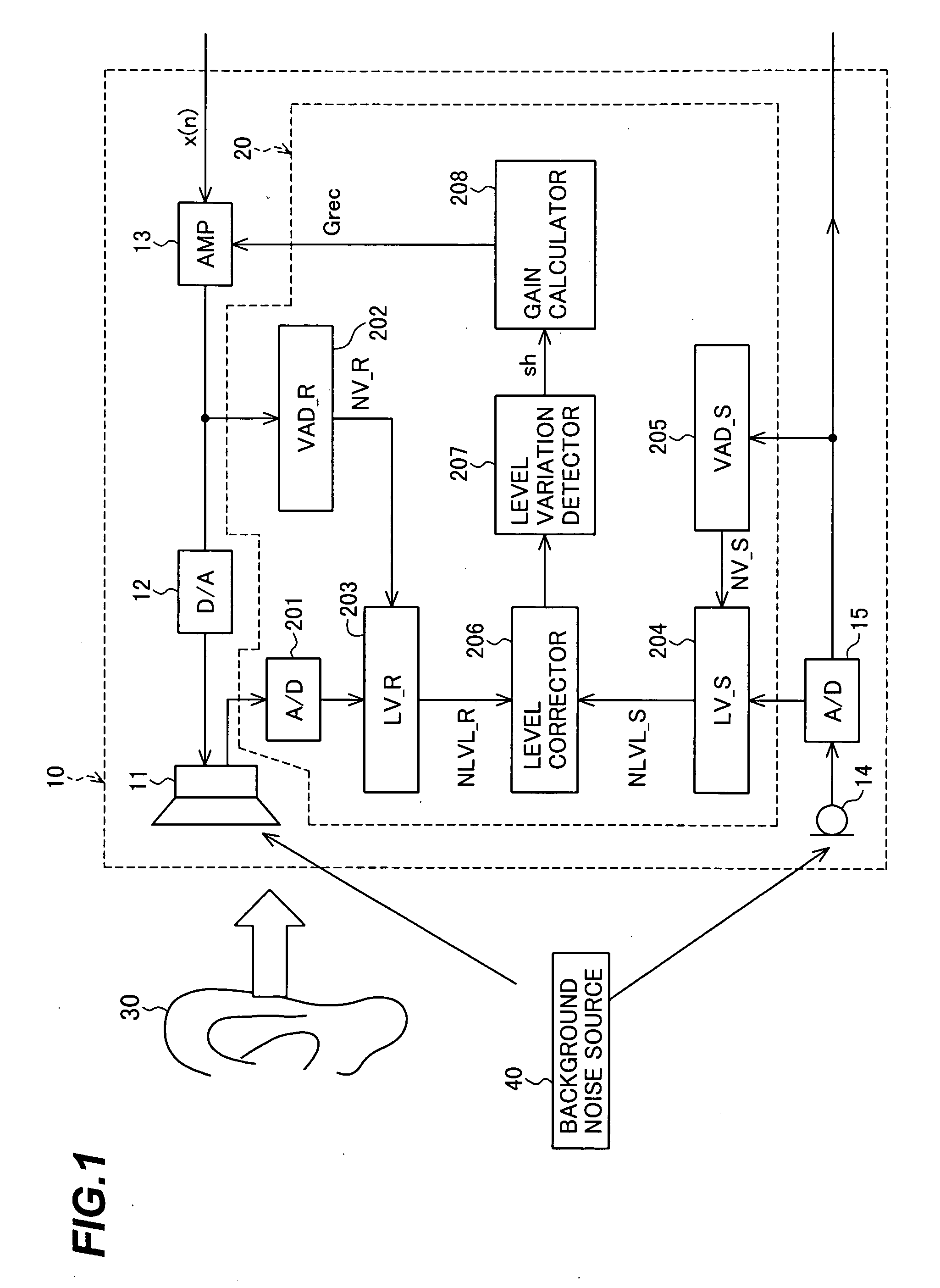Sound signal adjustment apparatus and method, and telephone
a technology of sound signal and adjustment apparatus, which is applied in the direction of gain control, electrical transducers, substation equipment, etc., can solve the problems of volume control problems, the voice of both parties in the telephone conversation may therefore become difficult to hear, and the portable telephone has become extremely small, so as to achieve convenient, practical and low-cost
- Summary
- Abstract
- Description
- Claims
- Application Information
AI Technical Summary
Benefits of technology
Problems solved by technology
Method used
Image
Examples
first embodiment
[0051]Referring to the block diagram in FIG. 1, the first embodiment is a telephone 10 including an ear speaker referred to below simply as a speaker 11, a digital-to-analog converter (DAC) 12, an amplifier (AMP) 13, a microphone 14, an analog-to-digital converter (ADC) 15, a sound signal adjustment apparatus 20, and numerous well-known elements, including pushbuttons and other manual controls, which are not shown.
[0052]The telephone 10 receives a far end signal x(n) from a distant party (not shown), reproduces it for the user (whose ear 30 is shown), picks up the user's voice, and transmits the user's voice to the distant party.
[0053]More specifically, when the user (also referred to below as the near end party) speaks into the microphone 14, the microphone 14 converts the user's voice to an analog electrical signal, which is converted to a digital signal by ADC 15 and transmitted as a near end signal to the distant party (also referred to below as the far end party).
[0054]The far ...
second embodiment
[0090]Referring to the block diagram in FIG. 5, the telephone 10A in the second embodiment differs from the first embodiment by including a modified sound signal adjustment apparatus 20A having a modified level variation detector 207A and a modified gain calculator 208A.
[0091]When condition (4) is true and condition (5) is false, differing from the level variation detector 207 in the first embodiment, the level variation detector 207A calculates a quantity Dif_lev_r by the following equation (6), and supplies the value of Dif_lev_r, instead of the detection signal sh, to the gain calculator 208A.
Dif_lev—r=NLVL—R—r2−NLVL—R—r1 (6)
[0092]The gain calculator 208A multiplies the value of Dif_lev_r by a parameter δ20 as in the following equation (7) to calculate a gain value (Grec) for the amplifier 13.
Grec=δ20×Dif_lev—r (7)
[0093]The parameter δ20 in equation (7) may have the value 2.0 (δ20=2.0). The amplifier 13 amplifies the far end signal x(n) by the gain calculated in the gain calcul...
third embodiment
[0097]Referring to the block diagram in FIG. 6, the telephone 10B in the third embodiment differs from the second embodiment by including a modified sound signal adjustment apparatus 20B having a modified receiving voice activity detector 202B inserted between the DAC 12 and the amplifier 13.
[0098]The modified receiving voice activity detector 202B in the third embodiment detects voice activity in the far end signal in the same way as in the first and second embodiments. The difference between the third embodiment and the first and second embodiments is that when voice activity is detected in the far end signal received from the amplifier 13, the receiving voice activity detector 202B supplies the far end signal to the DAC 12, but when no voice activity is detected in the far end signal, the receiving voice activity detector 202B stops supplying the far end signal to the DAC 12.
[0099]Although the sound signal adjustment apparatus 20B shown in FIG. 6 is a modification of the sound si...
PUM
 Login to View More
Login to View More Abstract
Description
Claims
Application Information
 Login to View More
Login to View More - R&D
- Intellectual Property
- Life Sciences
- Materials
- Tech Scout
- Unparalleled Data Quality
- Higher Quality Content
- 60% Fewer Hallucinations
Browse by: Latest US Patents, China's latest patents, Technical Efficacy Thesaurus, Application Domain, Technology Topic, Popular Technical Reports.
© 2025 PatSnap. All rights reserved.Legal|Privacy policy|Modern Slavery Act Transparency Statement|Sitemap|About US| Contact US: help@patsnap.com



